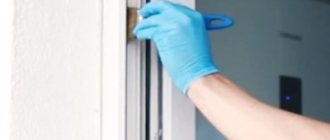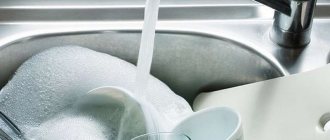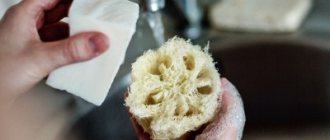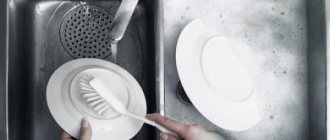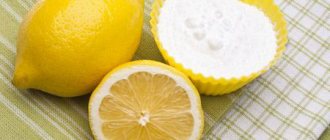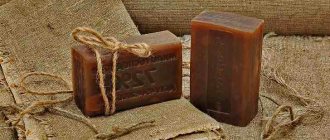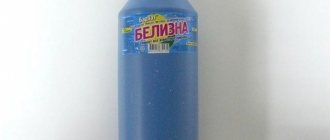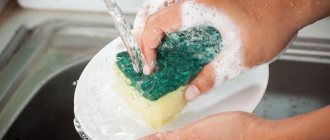Use lifehacks to remove difficult stains
Burnt food at the bottom of a pot or pan is every dishwasher's worst nightmare. Here are some tips to help remove dirt easier and faster.
- Place empty, dirty dishes on the stove and select the highest temperature. After some time, drop water inside the container. If a drop hisses and instantly evaporates, feel free to follow it with a whole glass of water at room temperature. As soon as the steam dissipates, mercilessly scrub off the stains with a wooden spatula.
- Fill the dishes with water, add detergent and boil for 10–20 minutes. After half an hour, when everything has cooled down, start cleaning the contaminated surface.
- Use these recommendations.
Traditional methods
Before the advent of modern cleaning products, housewives coped well with stains using simple folk remedies:
- Citric acid is a universal cleaner for removing scale, mold, and old dirt. It can be used in cleaning products made of enamel, cast iron, stainless steel, and ceramics. Citric acid is diluted in water, the solution is poured into a dirty container and boiled.
- Activated carbon is used to clean pans from burnt milk and dried porridge residues. 3-4 tablets are crushed into a pulp, the dirt is covered with them and the dishes are left for an hour. After this, grease and dirt are washed off better.
- Salt is used to clean cast iron and aluminum surfaces. You can rub it on the outside and inside of the pan. To clean other surfaces, adhering food residues are covered with salt, left for 2 hours, and washed.
- Mustard powder - ideal for sensitive, fragile surfaces. It is used in dry form, applied to a sponge, or the dishes are soaked in a solution of mustard powder.
- Wood ash. It is used to clean dishes from heavy grease and old dirt.
The main advantage of folk cleaning products is environmental safety for humans.
Don't clutter your sink
We've all experienced the situation where one dirty dish in the sink turns into a stinking mountain of dishes. Of course, it’s not always possible to wash everything at once, so you can use the following technique.
When you have the first and deep enough candidate for cleaning (for example, a saucepan or a large bowl), fill it with hot water and detergent, place it next to the sink (not in!) and put other dirty dishes in it.
This way, firstly, you will keep the sink empty, and secondly, you will prepare the dishes for express cleaning. Once soaked in hot water, it will clean up faster, you will be less tempted to leave it for later, and the kitchen is unlikely to turn into an Augean stable.
How to wash correctly: basic points
There are rules that make washing dishes easy and quick. We invite you to familiarize yourself with the main ones:
- Try to wash the least dirty items first, such as teaspoons and cups. Wash pans and greasy plates last.
- The water temperature should fluctuate between 40-50 degrees. Thanks to hot water, dishes are washed well.
- When washing containers of cottage cheese, raw eggs and dough, start with cold water. The hot water will coagulate the whites and they will stick to the surface.
- Do not immediately wash dishes with dried food residues. Soak it and let it sit for several hours.
Advice . If you want to involve your child in housework and ask him to wash the dishes, carry out this action in a playful way. Sort items by type: cups, spoons, forks, plates, pots and pans. Draw an analogy with a computer game and go through the first, easiest level - wash the spoons and forks. Then, as you increase the difficulty of the level, clean the cups and plates, and at the end of the “kill the boss” - wash the pots and pans.
Don't put everything in the dishwasher
Even if you are the proud owner of a dishwasher, you still cannot avoid washing dishes in the traditional way. At least if you don’t want to damage kitchen utensils and expensive equipment.
Here is a list of things that should not be put in the dishwasher:
- Cast iron products. They require more careful and caring care.
- Nice knives. They will dull faster if you wash them in a machine rather than by hand.
- Crystal. May crack or scratch.
- Wooden crafts. May become deformed.
- Cookware with non-stick coating. It all depends on the brand: some models are dishwasher safe, others are not. If you don't know for sure, it's better to use good old hands. Otherwise, your frying pans risk losing their professional suitability.
- Copper utensils. May change color.
- Plastic. The exception is for products made of hard plastic, on which the manufacturer has indicated that they can be washed in a machine.
- Gilded dishes. The machine can ruin the noble coating.
- Dishes with labels. When exposed to high temperatures, they can peel off and clog the dishwasher.
Rules for washing dishes made from various materials
There are rules and sanitary standards governing this procedure in public catering establishments:
- The crystal is rinsed in warm water using a soft cloth moistened with an alcohol solution;
- enamel products should not be washed with hard sponges that damage the coating;
- Cast iron cauldrons are washed in warm water using detergent. So that no traces remain, lubricate with oil and wipe with a napkin to remove any remaining grease;
- glass products should be washed with soapy water and warm water;
- Aluminum cookware is cleaned with soda and, after rinsing, wiped with a dry towel.
Dishes are made from different materials. When cleaning it, it is necessary to take into account the material and use the correct means for washing kitchen utensils. This will allow you to get the job done quickly and efficiently.
Effective approach
If a mountain of dishes has accumulated in the sink, it is better to immediately divide it into plates, cups and cutlery.
Each group should be washed in turn, and the foam should be washed off at the very end. It is best to use a regular soft sponge, which has a denser material on one side. The size of the sponge should be about the size of your palm, while too small a size can greatly slow down the process. Basic principles of quick washing:
- 1First, wet all the dishes and sponge and foam the product;
- 2The tap should be turned off while washing dishes, which will save on rent;
- 3Then they wash each “group” in turn: first the cutlery, then the cups and glasses, and leave the dirtiest plates and pots for last;
- 4When you have “walked” the sponge over all the dishes, you can open the tap and wash off the foam from all items one by one;
- 5It is best to dry the dishes on a regular towel, and then put the dry ones in the cupboard.
For very dirty things, you can use metal sponges or even stiff brushes. You should not try to scrape off food residues from pans and pots using forks and knives, as there is a risk of damaging the surface. If something is not washed off immediately, it makes sense to leave these items in the sink for a while, filling them with water.
A separate problem is caused by dishes in which something is burnt. This problem often occurs when cooking rice in a metal pan with thin walls. If you rub it with a metal sponge, it will deteriorate, but boiling water will not help here either. The most effective method involves exposure to steam. If you hold the pan upside down over boiling water, then 5-10 minutes is enough for the main remnants of burnt food to fall off on their own at such a high temperature. When this doesn’t help, the dishes are definitely ruined.
Tips for the future on how to quickly wash dishes:
- 1After feasts, do not put everything in one pile, but sort items at least according to the absence or presence of a greasy film;
- 2If the plates have been standing for a long time, then it makes sense to soak them in hot water for 15-20 minutes before starting to wash;
- 3After cooking cereals, it is important to immediately fill the pots and plates with water, because dried buckwheat and rolled oats cannot be washed quickly.
Stages
When washing dishes, it is important to maintain consistency. There are only 5 stages:
- Pre-cleaning.
- The washing up.
- Rinsing.
- Drying.
To remove pieces of food, it is best to use a wooden or silicone spatula. Metal objects may leave scratches on the cookware.
Wood ash
You can be critical of this, but ash will help you quickly and safely clean dishes (even children’s) from grease! It absorbs perfectly and dissolves fats. And how does it cope with burnt stainless steel surfaces and baking dishes!
How to properly wash dishes in this truly ancient way? First, get wood ash without any admixtures of burnt chemicals - plastic, polyethylene. This is easy to do for villagers who have stoves or fireplaces. Pour powdered product onto wet plates, wipe with a wet washcloth and rinse. That's all!
Aids
In the modern world, where there is always a store with a large selection of goods nearby, the question of detergent does not arise. You just need to choose the right one. To do this, you need to determine how and what dishes you will wash.
For women, the question often arises: how to properly wash dishes by hand without damaging the skin of your hands. For this purpose, there are now special means that will not have an aggressive effect on the hands. They have also produced special cleaning gels for children that do not harm the body. To protect yourself as much as possible, you should look at the composition of the gel or powder; it’s good if it contains as many natural ingredients as possible.
Another question: what is better to use - gel or powder? Gel can be used to wash “delicate” surfaces without damaging them, but powder copes better with complex stains. In fact, it is best to have both and use them depending on the situation.
It’s good, of course, when you have a special detergent at home, but if you’ve run out of it and are too lazy to run for it, don’t have time, or are there other reasons getting in the way? There are numerous ways to deal with oily stains without it.
Soda Ash
By the way, even now sanitary services recommend washing children's dishes in educational institutions with soda ash. So it's safe! You just need to dilute it correctly.
How to wash dishes: add a tablespoon of this alkali to a liter of hot water. The solution is ready! Hand wash the cups, plates, then cutlery with a washcloth. Then rinse everything thoroughly. Believe me, without any chemicals the plates will creak in your hands!
But pots and other larger kitchen utensils should be washed with slightly moistened soda, like a paste. Just wear gloves.
The washing location cannot be changed
Look at the sink in your home through the eyes of a stranger, a guest - a boring place, devoid of personality. And it doesn’t always meet hygiene standards - an old sponge is adjacent to a new one, a fresh towel hangs next to a napkin with greasy stains.
Decorative elements in the kitchen interior will not be out of place: a small detail above the sink or next to it, a stylish, funny little thing. Any souvenir will do, as long as it evokes good, personal emotions. It’s not a big deal, but now it’s nice to go to the sink.
Be sure to decide on a constant set of items on and around the work surface. These things catch your eye many times a day, so keep only the necessary and cute ones. The main thing is that you don’t have to look for anything, and everything is at hand - from rubber gloves to soft towels. Then you can quickly wash the dishes with your own hands in between times, during a commercial break or while waiting for the tea to brew.
What to do if there is no running water?
When washing cups and plates in an apartment, everything depends on the correct procedure. But what to do when there is no running water, no product, or even a sponge? You should think about cleaning at the dacha or at a picnic in advance and try not to mix greasy dishes with fairly clean ones. It is better to immediately allocate a place where glasses and cups, dishes with fried foods or plates for fresh vegetables and bread will be placed separately.
We suggest you read How to clean arctic fox fur at home: useful tips for cleaning white arctic fox fur from yellowness
Anything that does not have a greasy coating can simply be washed with water. When you have a sponge and a product, use them; if not, you can easily do it with your hands. It is most convenient for one person to handle the sponge and product, and the second to pour water and help rinse. If only one person does the dishes, then you can use 3 different basins. In the first, the dishes are washed with the product, in the second they are rinsed, and in the third, the remaining foam is finally removed.
So, the main tip for quickly washing dishes is to sort all items by size and degree of soiling. Then you need to completely soap everything, and only then wash off the foam with water. This is the rule that helps save a lot of time.
Subtleties of cleaning kitchen utensils
Now all that remains is to wash the items that were used for cooking. In this case, the following nuances must be taken into account:
- Copper and cast iron products that are burnt and covered with a layer of fat are cleaned with gel and then with soda using a steel wool. The washed cast iron frying pan is additionally calcined and greased with vegetable oil.
- Enameled pans are washed only with soda or mustard powder without abrasives. If there is a dark residue left in the pan after cooking the beets, boil potato or apple peels in it for an hour.
- Aluminum, on the contrary, does not tolerate contact with soda. It is tidied up with a soft sponge soaked in an aqueous solution of borax and ammonia (30 g: 10 g per 1 l). The pan is covered with the mixture for half an hour, and then wiped with a dry cloth and washed in several waters.
- All parts of the meat grinder are thoroughly washed, and the grate holes are cleaned with a match. The grater is cleaned with a steel wool and then poured with boiling water.
- Wooden cutting boards are soaped with soap (soda will darken them), and then scraped with a knife and doused with boiling water. Plastic is cleaned with soda. If fish was cut on a board, first rub it with half an onion.
Thus, well-organized work transforms washing dishes from an unpleasant task into a pleasure.
Pause in time
Train yourself and your family members to clear plates of leftover food before putting it in the sink. Then use the following method: place the dishes in a large bowl or basin, fill with hot water and add a couple of drops of detergent. It’s easier to wash plates and pans from old grease.
You can do without bowls: put the dishes in the sink, closing the drain, and leave them to soak in hot water. Don't mix everything together!
Now you have 10-15 minutes to check personal messages, calls or fill the cat with food. After which it would be good to remember that you are a champion and wash the dishes easily.
Sometimes there are too many dishes. For such cases, they practice the one soap sponge rule: wash with a sponge until it stops foaming. Then they pause, switching to another activity. The technique has long been known - a long distance divided into stages is easier to overcome. During a break, some people make the mistake of eating from clean plates again, which only adds more dishes.
Top 5 common mistakes
What can you do wrong when doing basic washing of dishes? Here are the top 5 common mistakes:
- Too much detergent. The generous soul of a Russian person does not allow him to put just a drop on a sponge. The result is an excess of surfactants on “cleanly washed” dishes.
- Wash the pan from the inside only. Men often sin with this, trying to rationalize any activity. As a result, even a new frying pan gradually becomes covered with “armor” of soot on the outside.
- Lack of care for glassware. A familiar picture from films is a bartender polishing glasses with a rag. These guys know what they're doing! If you let the glass dry naturally after washing, it will leave traces of drops. Over time, they will turn into a layer of cloudy plaque.
- Using inappropriate equipment. Old rags instead of sponges, hard washcloths and patterned dish brushes - the list goes on. Anything tougher than a typical foam sponge should be used sparingly and only as a last resort. And materials that rot in a humid environment (cotton, for example) are completely prohibited.
- Scraping dried food. The dirty plate had already dried out - and then you remembered about it. Take your time and fill it with water to loosen anything stuck to it.
